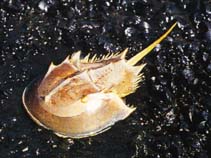Advertisement
Limulus polyphemus (Linnaeus, 1758)
Horseshoe crab| Native range | All suitable habitat | Point map | Year 2050 |

|
| This map was computer-generated and has not yet been reviewed. |
| Limulus polyphemus AquaMaps Data sources: GBIF OBIS |
country information
Common names:
[No common name]
Occurrence:
Salinity:
Abundance: | Ref:
Importance: | Ref:
Aquaculture: | Ref:
Regulations: | Ref:
Uses: no uses
Comments:
National Checklist:
Country Information:
National Fisheries Authority:
Occurrences: Occurrences Point map
National Database:
Occurrence:
Salinity:
Abundance: | Ref:
Importance: | Ref:
Aquaculture: | Ref:
Regulations: | Ref:
Uses: no uses
Comments:
National Checklist:
Country Information:
National Fisheries Authority:
Occurrences: Occurrences Point map
National Database:
Common names from other countries
Classification / Names Tên thường gặp | Các synonym ( Các tên trùng) | Catalog of Fishes (gen., sp.) | ITIS | CoL | WoRMS
Environment: milieu / climate zone / depth range / distribution range Sinh thái học
Distribution Các nước | Các khu vực của FAO | Các hệ sinh thái | Những lần xuất hiện | Những chỉ dẫn
Western Atlantic: from Maine, USA to Mexico.
Length at first maturity / Bộ gần gũi / Weight / Age
Maturity: Lm ? range ? - ? cm Max length : 60.0 cm TL con đực/không giới tính; (Tài liệu tham khảo 82); Khối lượng cực đại được công bố: 1.8 kg (Tài liệu tham khảo 82); Tuổi cực đại được báo cáo: 20 các năm (Tài liệu tham khảo 99652)
The males are approximately 1/3 the size of the females (sexual dimorphism) (Ref. 83). Lives in shallow waters, with sandy or muddy bottoms (Ref. 76). Found in intertidal and offshore areas (Ref. 1131). The horseshoe crab feeds at night on polychaete worms such as Cerebratulus, Nereis, and Cistenides (Ref. 76, 77), small mollusks, and seaweed (algae) found in the sandy ocean bottom (Ref. 76). Food is picked up by the chelicerae and passed back to the bristle bases, where it is "chewed." The food is then moved forward to the mouth (Ref. 75). It digs its food from sediments, grasping the prey with its legs. The prey is moved to the gnathobases where it is crushed before being pushed forward toward the mouth (Ref. 77). A life span of about 20 to 40 years (Ref. 78). Its predators are loggerhead turtles, pufferfish, leopard sharks and sea gulls (Ref. 82).
Life cycle and mating behavior Chín muồi sinh dục | Sự tái sinh sản | Đẻ trứng | Eggs | Sự sinh sản | Larvae
They reproduce with the use of the first pair of the six, flap-like appendages on the underside of the abdomen acts as a cover for the genital pore. The egg or sperm are released through this pore during spawning (Ref. 75). These eggs are fertilized by sperm released by an attached male and by one or more satellite males that typically congregate around the nesting pair (Ref. 81). While nesting, females bury themselves in the sediment near the water's edge and lay a series of discrete egg clusters, each containing 2,000-20,000 eggs (Ref. 80).
Main reference
Các tài liệu tham khảo | Người điều phối | Người cộng tác
Lee, C.N. and B. Morton. 2005. (Tài liệu tham khảo 1131)
IUCN Red List Status
(Tài liệu tham khảo 130435: Version 2024-2)
Dễ bị tổn thương, xem Sách đỏ của IUCN (VU) (A3bd); Date assessed: 17 February 2016
CITES status (Tài liệu tham khảo 108899)
Not Evaluated
CMS (Tài liệu tham khảo 116361)
Not Evaluated
Threat to humans
Harmless
Human uses
Các nghề cá: Tính thương mại
FAO - Các nghề cá: landings | FIRMS (Stock assessments) | FishSource | Biển chung quanh ta
Các công cụ
Thêm thông tin
Các nước
Các khu vực của FAO
Các hệ sinh thái
Những lần xuất hiện
Những chỉ dẫn
Stocks
Sinh thái học
Thành phần thức ăn
Các loại thức ăn
Các khu vực của FAO
Các hệ sinh thái
Những lần xuất hiện
Những chỉ dẫn
Stocks
Sinh thái học
Thành phần thức ăn
Các loại thức ăn
Tên thường gặp
Các synonym ( Các tên trùng)
Các động vật ăn mồi
Sự tái sinh sản
Chín muồi sinh dục
Đẻ trứng
Sự sinh sản
Eggs
Egg development
Các synonym ( Các tên trùng)
Các động vật ăn mồi
Sự tái sinh sản
Chín muồi sinh dục
Đẻ trứng
Sự sinh sản
Eggs
Egg development
Các nguồn internet
BHL | BOLD Systems | CISTI | DiscoverLife | FAO(Các nghề cá: ; publication : search) | GenBank (genome, nucleotide) | GloBI | Gomexsi | Google Books | Google Scholar | Google | PubMed | Cây Đời sống | Wikipedia (Go, tìm) | Tạp chí Zoological Record
Estimates based on models
Preferred temperature
(Ref. 115969): 12.5 - 28, mean 26.7 (based on 417 cells).




